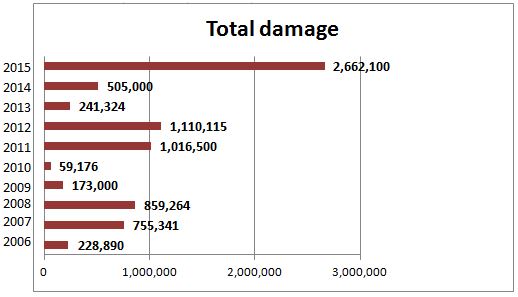Do not call the forest that shelters you a jungle ~ African Proverb
Overview
Boasting as the second largest continent in size and population, Africa is home to approximately 1.2 billion people spread over 54 countries. The location of the African continent – surrounded by the Mediterranean Sea, the Indian Ocean, and the Atlantic Ocean – exposes it to a mix of climates. Most of the Northern parts of the continent are deserts and arid or semi-arid regions, while the rest of the continent is a mix of savanna plains and rain-forest. Despite Africa's ecological richness and beautiful landscapes, the risk of fragmentation and degradation are apparent. A recent example is the receding lake Chad in the Sahel region.
The increasing population further poses a strain on the available resources in most of the countries. The African economies are heavily dependent on natural resources. In assessing the non-linearity in the effect of temperature on global economic production, Burke, Hsiang and Miguel (2015) affirmed that by 2100, most African countries would be poorer than present if the rising temperatures and effects of climate change are not mitigated against. Perhaps the most important question is how can environmental sustainability and resilience be achieved in Africa amid the rising populations and persistent exposure to natural hazards?
The increasing population further poses a strain on the available resources in most of the countries. The African economies are heavily dependent on natural resources. In assessing the non-linearity in the effect of temperature on global economic production, Burke, Hsiang and Miguel (2015) affirmed that by 2100, most African countries would be poorer than present if the rising temperatures and effects of climate change are not mitigated against. Perhaps the most important question is how can environmental sustainability and resilience be achieved in Africa amid the rising populations and persistent exposure to natural hazards?
Disaster Profile
Beyond the size, resource-richness and endearing beauty of the African continent, the the risk of occurrence and exposure to climatic events remain constant. The most prevalent natural disasters in Africa are the floods, storms, drought, wildlife and extreme temperatures (EM Database). The frequency of occurrence of these disasters has varied from 2006-2015 although in totality, the floods, storms and drought are common phenomena.
 |
| Frequency of occurrence of natural disasters in Africa from 2016-2015 (Source of data: EM DAT database) |
 |
| Variation in occurrence of disasters (floods, storms, drought, extreme temperatures and wildfire) in Africa from 2006-2015 (Source of Data: EM Database) |
Although flood is the most common natural hazard in Africa, there is a variation among countries in terms of prevalence. For instance, Kenya has experienced 28 floods within the 10 year period as compared to 1 flood event in Libya. Other Africa countries prone to floods - with 10 or more flood events - include Angola, Ethiopia, Nigeria, Burundi, Algeria, DR Congo, Malawi, Mozambique, Niger, Tanzania, Burkina Faso, Mali, Sudan, Chad, Ghana and Morocco, in descending order.
 |
| Prevalence of flood events in various African countries from 2016-2015 (Source of data: EM DAT database)
Flooding is mostly common in low elevation zones of Africa where, according to Kamal-Chaoui and Robert (2009), are inhabited by approximately 1-5 million people. A study by Di Baldassarre et al 2010 also found that the risk to floods in most African countries has increased due to intensive yet unplanned developments in flood-prone areas.
Between 2006-2015, droughts has occurred 5 times in Ethiopia and; 4 times in Kenya and Zimbabwe; 3 times in Burundi, Djibouti, Malawi, Mali, Mozambique and the Niger. The very nature of droughts - slow onset - means that a drought event can take longer to be manifested. Implications
At 20,004 deaths between 2006-2015, droughts have caused the majority of natural disaster-related fatalities in Africa despite their low occurrence. The high numbers are due to the Somalia drought that led to the loss of approximately 20,000 lives, due to hunger and lack of water, leading to the highest number of total deaths from the five disasters as shown in the graph. The floods caused 25,360 deaths within the same period followed by storms (1,356) and wildfire (131). The figures below summarize the losses and damages from the disasters in question in Africa for the period 2006-2015.
|
 |
| Total occurrence of disasters (floods, storms, drought, extreme temperatures and wildfire) vs fatalities in Africa from 2006-2015 (Data from source: EM Database) |
 |
| Total number of people affected from disasters (floods, storms, drought, extreme temperatures and wildfire) in Africa between 2006-2015 (Data from source: EM Database) |
 |
| Total damage (x1000 US Dollars) resulting from disasters (floods, storms, drought, extreme temperatures and wildfire)in Africa between 2006-2015 (Data from source: EM Database) |
Conclusion
The past rhythm of disasters in Africa is not so appealing to the ear after all. Can the future be any better? The impacts of climate change are projected to increase under business-as-usual scenario and this is bound to have implications across continents and regions. It is therefore safe to argue that with heightened level of exposure to the risks of natural disasters coupled with low adaptive capacity in Africa, climate change is set to increase vulnerability. It is also worth noting there are a number of concrete initiatives that have been rolled around out by countries and various agencies around the continent to reverse the current disaster trends, help communities adapt and build resilience. These responses will be discussed in the subsequent posts. Stay tuned.









